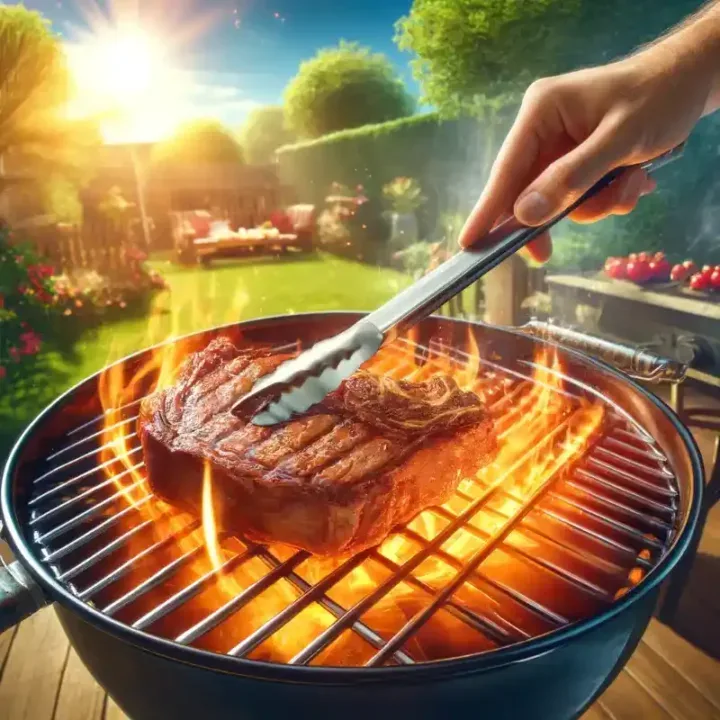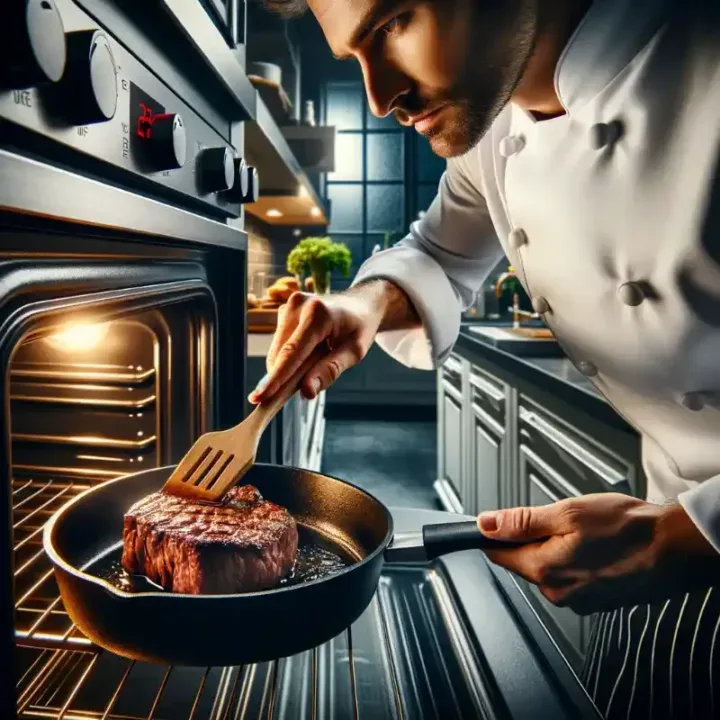Introduction
Cooking the perfect tender steak is an art that combines the right cut of meat with expert cooking techniques. Whether you’re looking to replicate the melt-in-your-mouth texture of a restaurant-quality steak or just aiming to improve your home cooking, this guide will provide you with all the necessary tips and tricks. From selecting the best cuts to mastering various cooking methods, we’ll explore how to enhance the tenderness and flavor of your steak. Our comprehensive approach will ensure that every steak you cook from now on is not just good, but great. So, let’s dive into the culinary techniques that will elevate your steak game to professional levels.
What You’ll Need
Equipment Necessary for Steak Preparation
To achieve the perfect tender steak, certain kitchen tools are essential. Firstly, a high-quality skillet, preferably cast iron, is critical for even heat distribution and achieving a good sear. A meat thermometer will ensure your steak reaches the ideal internal temperature without overcooking. Tongs are preferable over forks for turning the steak, as they do not pierce the meat, which can cause valuable juices to escape. Additionally, a good cutting board and a sharp chef’s knife are vital for handling and slicing your steak properly.
Preparing the Steak and Cooking Area
Before you begin cooking, it’s crucial to set yourself up for success. Start by allowing the steak to come to room temperature, which can take about 30 to 40 minutes. This step is essential for ensuring your steak cooks evenly. While the steak is resting, you can prepare your cooking area. Make sure your skillet is clean and you have all your tools and seasonings within reach. Preheating your skillet is also vital; it should be hot before the steak touches the surface to achieve a perfect sear that locks in flavors.
Ingredients
Selecting the Right Steak
The cut of steak you choose is paramount in determining tenderness. Tender cuts like the ribeye, filet mignon, or sirloin are preferred for their fine texture and fat distribution, which contribute to a more succulent finished dish. Each of these cuts offers different attributes: ribeye is richly marbled with fat, filet mignon is exceptionally tender with less fat, and sirloin offers a good balance of tenderness and flavor without too much fat.
Marinades and Seasonings Tender Steak
To enhance tenderness and flavor, consider using a marinade. Marinades not only add flavor but also help to tenderize the meat, especially if they contain acidic ingredients like lemon juice or vinegar, or natural enzymes found in fruits like pineapple or papaya. Basic seasonings such as salt and pepper are essential, but you can also experiment with garlic powder, smoked paprika, or a touch of cayenne for heat. Apply your seasonings or marinade at least an hour before cooking, which allows them to penetrate and flavor the meat adequately.
Instructions
Cooking Techniques to Maximize Tenderness

The method you choose to cook your steak significantly affects its tenderness. Techniques such as reverse searing, where you slowly roast the steak in the oven before finishing it in a hot skillet, can produce a uniformly cooked interior and a beautifully caramelized crust. Another effective method is sous-vide, which involves vacuum-sealing the steak and cooking it in a water bath at a precisely controlled temperature, resulting in perfect doneness and maximum tenderness. To learn more about how different cooking methods can affect the tenderness of beef, explore our detailed guide.
Checking Doneness and Resting
Using a meat thermometer, check the internal temperature of your steak to determine doneness: 135°F for medium-rare, 145°F for medium, 155°F for medium-well, and 165°F for well done. Regardless of your preferred level of doneness, always let your steak rest for about 5 to 10 minutes after cooking. Resting allows the juices to redistribute throughout the meat, ensuring a juicy, tender steak when sliced.
Nutrition Facts
Nutritional Value of Different Steak Cuts
Understanding the nutritional content of various steak cuts can help you make informed dietary choices. Generally, steak is an excellent source of protein, which is crucial for muscle repair and growth. It also provides a significant amount of iron, which helps in transporting oxygen throughout the body. However, the fat content can vary widely between cuts. For instance, ribeye steaks are higher in fat, particularly saturated fat, compared to leaner cuts like sirloin or filet mignon. Choosing the right cut depends on your nutritional preferences and health goals, whether you’re looking for lower calorie options or aiming to increase your protein intake.
Health Benefits and Considerations
Including steak in your diet offers several health benefits, such as supplying essential nutrients including B vitamins, iron, and zinc. These nutrients are vital for energy production, immune function, and overall cellular health. However, it’s important to consider the frequency and portion sizes of steak consumption in the context of a balanced diet. Consuming high amounts of red meat has been linked to certain health risks, such as increased chances of heart disease and certain cancers. Balancing steak intake with plenty of vegetables, whole grains, and other sources of lean protein can help mitigate these risks.
Serving & Storage
Serving Suggestions
To fully enjoy your tender steak, pairing it with complementary sides can enhance the meal. Classic pairings include a baked potato, steamed vegetables, or a fresh salad. For a low-carb option, consider serving it with roasted cauliflower or a mix of sautéed green vegetables like spinach and asparagus. Additionally, a robust red wine or a full-bodied beer can complement the rich flavors of the steak, making for a more rounded dining experience.
To elevate your steak dinner, you might consider complementing your meal with a slice of quality cheese, such as white cheddar.
Storage Tips
Proper storage is key to maintaining the quality and safety of leftover steak. Store cooked steak in an airtight container and refrigerate it within two hours of cooking. It’s best consumed within three days. When ready to eat, reheating the steak properly can help preserve its tenderness. Avoid microwaving if possible; instead, gently reheat the steak in a pan over low heat to keep it moist and tender.
Variations
Creative Marinades and Rubs
Experimenting with different marinades and rubs can bring a new flavor profile to your tender steak. Consider ethnic flavors like a chimichurri sauce, which adds a vibrant, herby touch, or an Asian-inspired marinade with soy sauce, ginger, and garlic. For something with a kick, a spicy Cajun rub can provide a bold taste. Each marinade or rub not only enhances flavor but can also contribute to the tenderizing process, giving you even more tender results.
Alternative Cooking Methods

While traditional pan-searing is popular, exploring other cooking methods like grilling or broiling can offer different textures and flavors. Grilling imparts a smoky flavor that’s hard to achieve indoors, while broiling is a great alternative to mimic high-heat, restaurant-style cooking at home. Each method has its nuances and can be adapted depending on the steak cut and your flavor preferences.
The Science of Meat Aging
Aging meat is a revered technique used to enhance the flavor and tenderness of steak. Here’s what happens during the aging process:
Dry Aging
- Process: During dry aging, large cuts of beef are stored in a controlled, open-air environment for several weeks. This exposure to air allows the meat’s natural enzymes to break down muscle fibers and connective tissues, which enhances tenderness.
- Flavor Development: Dry aging also concentrates the flavors by allowing moisture to evaporate from the muscle, resulting in a greater concentration of beef flavor and taste.
Wet Aging
- Process: Wet aging involves vacuum-sealing meat in plastic and allowing it to age in its own juices. This process also utilizes the meat’s natural enzymes but does so in a moisture-rich environment, which prevents dehydration.
- Flavor and Texture: Wet aging typically produces a steak that is tender but with a slightly different texture and a less concentrated flavor compared to dry-aged meat.
Both aging processes make the steak more tender, but the choice between dry and wet aging can affect the texture, flavor, and overall culinary experience. Whether you prefer the bold taste of dry-aged steak or the subtle flavors of wet-aged, understanding these processes can help you make better choices when selecting steak.
To enhance your understanding of meat tenderization, particularly its biochemical processes, you might find the information from an article on Food Production, Processing and Nutrition useful. It delves into the role of small heat shock proteins (sHSPs) and their interaction with myofibrils, the calpain system’s function in proteolysis during postmortem aging, and how this contributes to meat tenderness. These insights are valuable for understanding the scientific mechanisms that influence the texture of meat.
For a detailed read, you can check out the article here: Techniques for postmortem tenderisation in meat processing.
Essential Steak Cooking Tools and Techniques
To achieve the perfect tender steak, understanding and utilizing the right tools and techniques is crucial. This section focuses on essential equipment and methodologies that enhance the cooking process, ensuring your steak is not only tender but also deliciously irresistible.
Must-Have Tools for Cooking Steak
- Cast Iron Skillet: The best tool for achieving a well-seared crust and even cooking. Its ability to retain high heat makes it ideal for cooking steaks.
- Digital Meat Thermometer: Ensuring your steak is cooked to the desired doneness without overcooking is essential for tenderness. A digital meat thermometer gives you precise control.
- Tongs: To handle the steak without piercing it, which can cause juices to escape, tongs are preferred over forks.
Advanced Cooking Techniques
- Reverse Searing: Ideal for thicker cuts, this technique involves slowly cooking the steak in a low-temperature oven before searing it in a hot skillet. This method ensures even cooking and a tantalizing crust.
- Butter Basting: After searing, adding butter, herbs, and garlic to the skillet and continuously spooning it over the steak can infuse additional flavors and aid in achieving a tender, juicy steak.
- Resting the Meat: Allowing the steak to rest after cooking is critical. Resting for 5-10 minutes lets the juices redistribute throughout the meat, resulting in a more tender, flavorful steak.
These tools and techniques are fundamental for any steak lover aiming to elevate their cooking skills. By mastering these aspects, you can transform a good steak into an extraordinary meal that rivals those of the best steakhouses.
FAQs
What Cut of Steak is Most Tender?
The tenderness of steak varies significantly across different cuts. The most tender cut is the filet mignon, also known as tenderloin. This muscle does very little work, making it incredibly tender. Other tender cuts include the ribeye, which has a rich marbling that adds to its tenderness and flavor, and the sirloin, known for its leaner profile yet tender enough for most steak lovers.
How Do You Make Steak Soft and Tender?
Achieving a soft and tender steak can be managed through proper selection, preparation, and cooking:
- Marination: Using acidic ingredients like lemon juice or vinegar in your marinade can help break down tough muscle fibers.
- Physical Tenderizing: Using a meat mallet to tenderize the steak before cooking can physically break down fibers.
- Proper Cooking: Avoiding overcooking and using methods that cook the steak evenly, such as sous-vide, can maintain its tenderness.
What is the Secret to a Tender Steak?
Several factors contribute to the tenderness of a steak:
- Choosing the Right Cut: Opting for naturally tender cuts like filet mignon.
- Marination: Marinating the steak can add flavor and tenderize tough cuts.
- Controlled Cooking: Cooking at the right temperature to the correct doneness without overcooking helps preserve tenderness.
- Resting: Allowing the steak to rest after cooking lets the juices redistribute, enhancing tenderness and flavor.
How Do Restaurants Make Their Steaks So Tender?
Restaurants often use a combination of high-quality cuts and expert cooking techniques to ensure tenderness:
- High-Quality Meat: Sourcing the best grades of meat with optimal marbling.
- Aging: Many steakhouses dry-age their beef to break down muscle fibers and enhance flavor and tenderness.
- Precise Cooking: Using professional cooking methods like broiling with high-temperature ovens or grilling over open flames to achieve a perfect sear and ideal internal temperature.
Conclusion
Mastering the art of cooking a tender steak requires an understanding of meat cuts, preparation techniques, and proper cooking methods. By following the tips outlined in this guide—from selecting the right cut to employing the best cooking practices—you can enjoy steakhouse-quality meals in the comfort of your own home. Remember, the key to a succulent, tender steak lies in the details of how you prepare and cook it. Embrace these techniques, and transform your next steak dinner into a gourmet experience.
If you’re interested in other beef dishes that are guaranteed to be tender and flavorful, try these chuck roast recipes.

